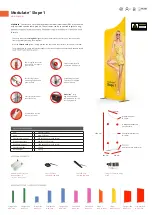
854 Quad Bender
Greenlee / A Textron Company
4455 Boeing Dr. • Rockford, IL 61109-2988 USA • 815-397-7070
13
Special Bending Information
The Special Bending Information section and the
Special Bending Information Chart are used together for
making very precise bends.
The Special Bending Information Chart is divided into
sections by the size and type of conduit. Each section
contains dimensions (such as Y, L1, L2, and Z) that
correspond to the illustrations. The top row of the
Special Bending Information Chart shows some of the
typical heights (2", 4", 6", etc), which correspond to the
heights in the illustrations.
SINGLE BENDS (Stubs and Kicks)
1. Select the size and type of conduit. Determine the
height of the stub or kick and the angle to be used.
2. Find the corresponding section of the Special
Bending Information Chart.
3. In the row at the top of the page, find the height of
the stub. Under the height, find the corresponding
Y dimension.
4. Mark the conduit as shown. Bend the conduit.
Y
HEIGHT
MARK
ANGLE
OFFSETS
An offset is used to route the conduit around an
obstruction. To make an offset, two equal bends are
required. The distance between the two bends is the
center-to-center distance.
When working past an obstruction, it is necessary to
determine the location of the first bend. The center-to-
center distance is then used to measure and mark the
distance to the second bend.
When working toward an obstruction, it is necessary to
determine the location of the second bend. The center-
to-center distance is then used to measure and mark
the distance to the first bend.
Offsets — Working Past an Obstruction
1. Select the size and type of conduit. Measure the
height of the obstruction and the distance labeled
LENGTH. Determine the angle to be used.
2. Find the X dimension in the X Table under Bending
Instructions. Subtract X from the LENGTH and mark
the conduit, as shown.
3. Find the corresponding section of the Special
Bending Information Chart.
4. In the row at the top of the page, find the height of
the obstruction. Under the height, find the corre-
sponding L1 dimension.
5. Mark the conduit as shown. Bend the conduit.
Note: After the first bend, do not remove the
conduit from the bender. Advance the conduit until
the second bending mark is aligned with the front
edge of the hook, rotate the conduit 180°, and make
the second bend.
START OF
FIRST BEND
LENGTH
ANGLE
HEIGHT
BENDING
MARK 1
BENDING
MARK 2
LENGTH – X
L1
Offsets — Working Toward an Obstruction
1. Select the size and type of conduit. Measure the
height of the obstruction and the distance labeled
LENGTH TO END OF SECOND BEND. Determine
the angle to be used.
2. Find the corresponding section of the Special
Bending Information Chart.
3. In the row at the top of the page, find the height of
the obstruction. Under the height, find the corre-
sponding L1 and Z dimensions.
4. Mark the conduit as shown. Bend the conduit.
Note: After the first bend, do not remove the
conduit from the bender. Advance the conduit until
the second bending mark is aligned with the front
edge of the hook, rotate the conduit 180°, and make
the second bend.
BENDING
MARK 1
BENDING
MARK 2
HEIGHT
LENGTH TO END OF SECOND BEND
ANGLE
LENGTH – Z
L1













































